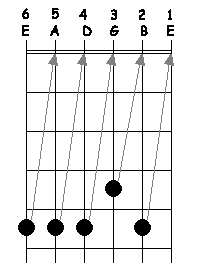
If one string of your guitar is in tune, it's possible to tune the other strings in relation to it.
Using some reliable reference pitch (e.g. a tuning fork) tune one string to pitch. For this example, let's assume that you're able to tune the 5th (A) string.
Once the 5th string is in tune, fret the 5th string at the 5th fret, thus producing a D note - the pitch of the next string up. Play an open 4th string and adjust the pitch until it produces the same pitch as the fretted 5th string. Repeat this process, using the 5th fret of the 4th and 2nd strings, and the 4th fret of the 3rd string to tune each string in turn.
You can use a similar technique for tuning lower pitch strings from higher ones. For example, when tuning the 6th string from the 5th string, fret the 6th string at the 5th fret and play the open 5th string. Take your hand off the 6th string and adjust the pitch as necessary, repeating this until the string is in tune. |
 |
If your guitar has a 'floating bridge' (i.e. a tremolo system which allows the pitch of the strings to be altered) then you need to bear in mind that adjusting the tension of one string during tuning could pull the bridge, thus altering the tension (and so the pitch) of all of the strings. In such a case you'll need to check and adjust any strings that you've previously tuned to pitch, including the string tuned to your reference pitch.
Thankfully, devices such as electronic tuning meters have become more affordable in recent years, which make the tuning process far simpler. However, understanding how to use relative tuning is a useful skill to have - you can't always rely on having a tuning meter to hand.
Also, this is a useful technique for tuning your guitar to a different tuning. For example, it's quite common to 'slack tune' the guitar down, so that all strings are a semitone below normal pitch. Not all tuning meters have these notes (the cheaper ones only support the standard open string pitches). However, if you know how to tune a guitar using the technique shown here, then you're not stuck as the ratios between the strings are the same.
For reference, click ![]() here to
hear what the open strings should sound like.
here to
hear what the open strings should sound like.
How useful did you find this tutorial?
| Product/Info... | PhatPhish Application | | | Product Help | | | GUPPY - PhatPhish for the web | | | About The Author |
|---|
| Get Stuff... | Download PhatPhish | | | Mechandise | | | Blank Stave And Tab Sheets | | | Tutorials |
|---|
| Do Stuff... | Register | | | Feedback | | | Links | | | Donate | | | Ask A Question |
|---|
| Social Media... | YouTube | | | | |
|---|
| Promote... | Spread The Word | | | Posters/Flyers |
|---|
| Play... | PhatPhish Picks - Boutique Plectrums |
|---|
| ©2002-2022, Dave Dixon / CyberFlotsam http://www.cyberflotsam.com |